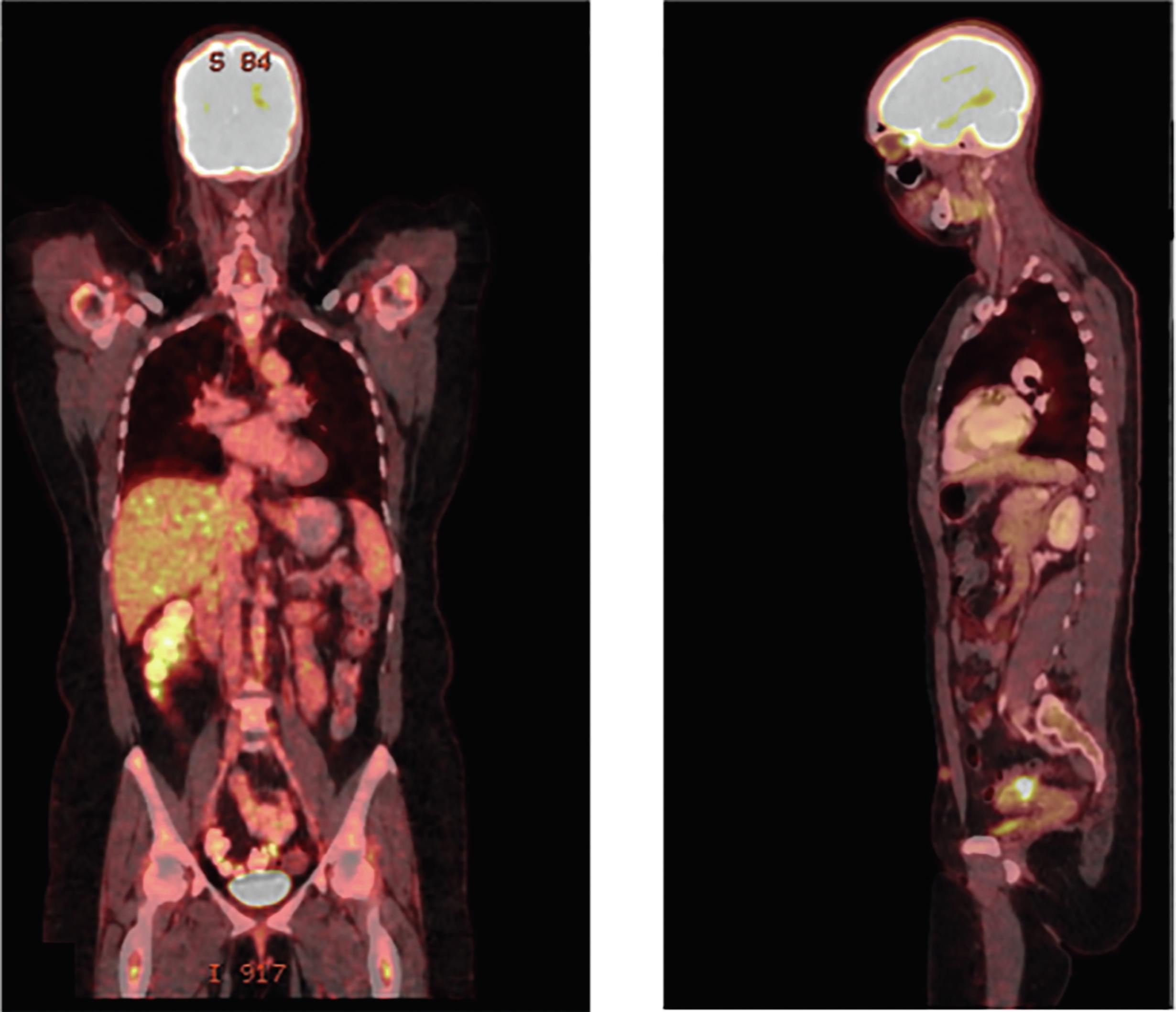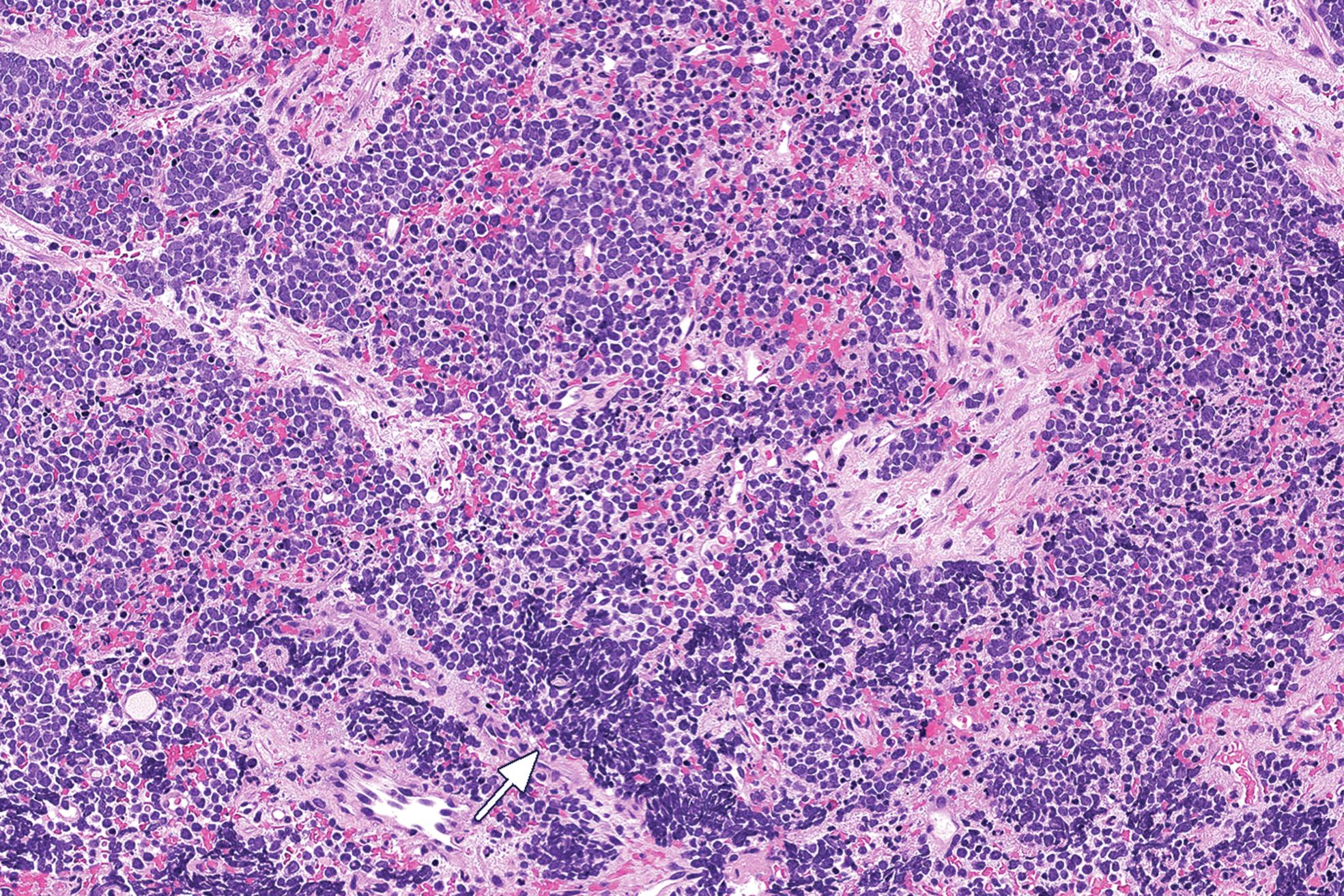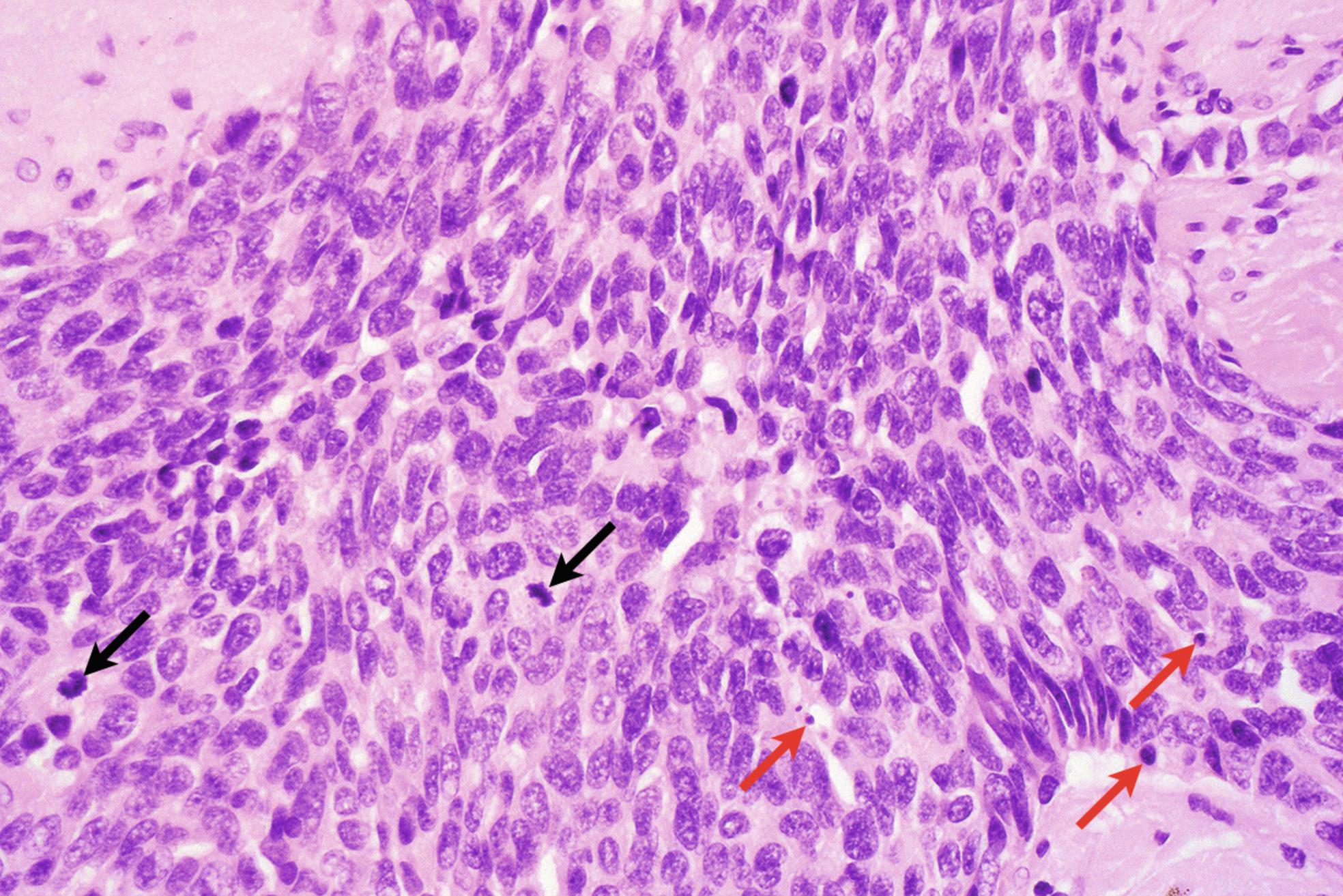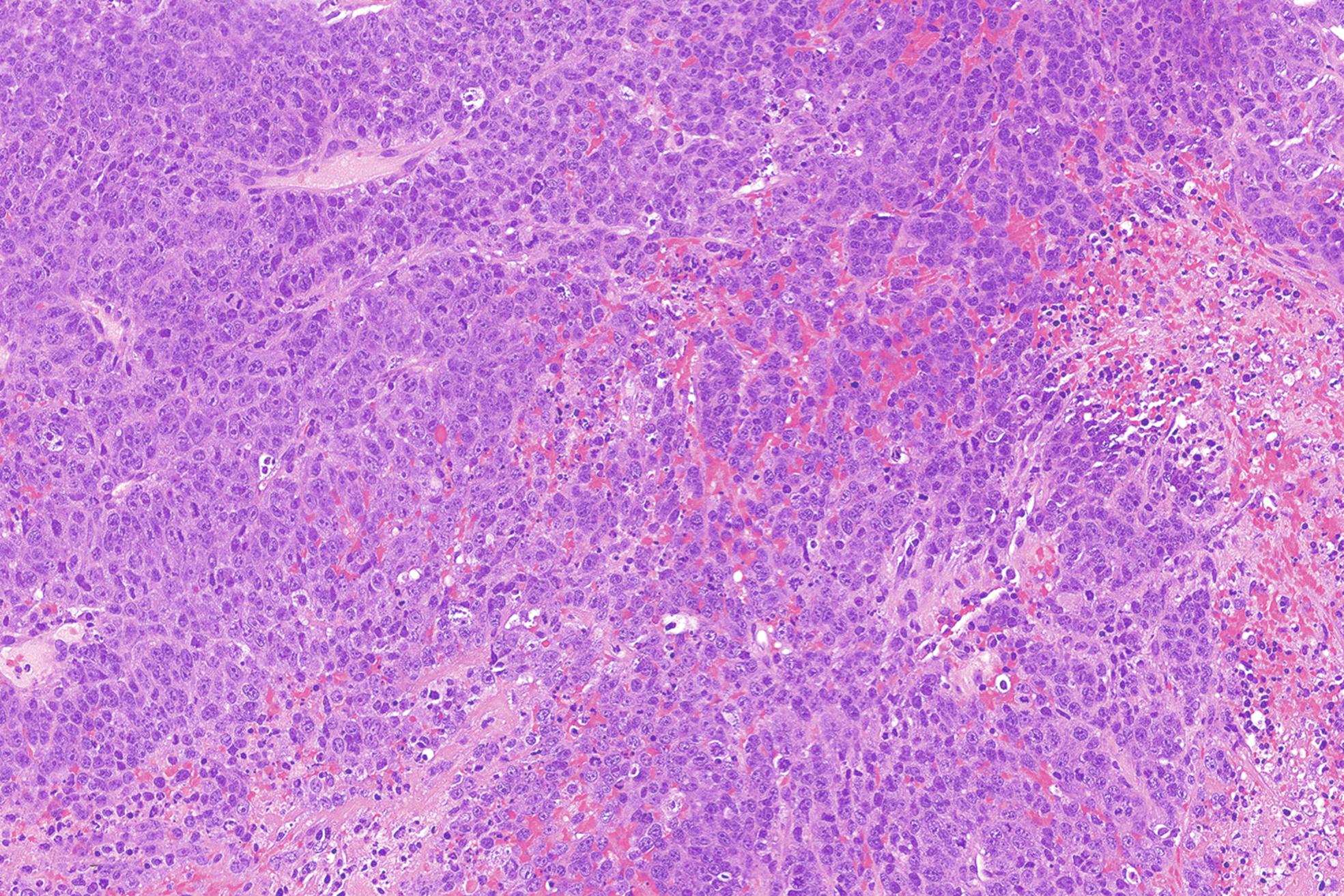Physical Address
304 North Cardinal St.
Dorchester Center, MA 02124
A 32-year-old G0 female presents with a newly diagnosed small cell neuroendocrine carcinoma (NEC) of the cervix. On physical exam, she is noted to have a 1.5 cm lesion on the anterior lip of the cervix with no evidence of vaginal or parametrial involvement. MRI of the pelvis reveals an isolated 1 cm lesion on the anterior lip of the cervix and confirms no vaginal or parametrial involvement. A PET scan shows no evidence of metastatic disease ( Fig. 14.1 ). The patient desires fertility sparing treatment for her disease. How do you treat this patient?

The broad category of NEC accounts for a variety of tumor subtypes. Carcinoid and atypical carcinoid tumors are considered low grade and most frequently found in the gastrointestinal (GI) tracks. Although there are case reports of these low grade tumors arising in the cervix, they are almost always metastatic sites from a GI primary and a full workup in search of a GI site should be undertaken. In the cervix, almost all primary neuroendocrine tumors (NETs) are high grade lesions (see Section “ Pathology ”).
High grade NEC of the cervix account for 1%–2% of cervical cancer diagnoses. The World Health Organization (WHO) further classifies high grade NEC of the cervix into two categories—small cell and large cell carcinomas. As there will be 14,480 cases of cervical cancer in the United States in 2021, a rough calculation will find approximately 150–200 cases/year for the entire country. The median age at diagnosis for patients with high grade NEC of the cervix is 48 years old which is younger than the age for those women diagnosed with squamous or adenocarcinomas of the cervix. Women with high grade NETs are also more likely to present with advanced stage disease than women with squamous or adenocarcinomas of the cervix. Although almost a third of patients will present with clinical stage I disease, an almost equivalent number will have stage IV disease at diagnosis ( Table 14.1 ).
| Stage a | Percent of cases | 5 Year overall survival |
|---|---|---|
| IA | 2.8% | 82% |
| IB | 29.8% | 55% |
| IIA | 0.8% | — b |
| IIB | 10.8% | 22% |
| IIIA | 1.4% | — b |
| IIIB | 21.8% | 24% |
| IVA | 3.2% | 4% |
| IVB | 25.7% | 7% |
| IV NOS | 3.7% |
Stage for stage, women with NEC have significantly worse outcomes than those with squamous or adenocarcinomas of the cervix ( Table 14.1 ). Even in those women where disease is clinically limited to the cervix, the 5-year overall survival is only 55% compared to 80%–85% for squamous and adenocarcinomas of the cervix. This speaks to the aggressiveness of the disease as 40% of patients with tumors < 4 cm and clinically limited to the cervix will have metastatic disease to pelvic nodes compared to only 10%–15% of similarly sized tumors that are squamous cell or adenocarcinoma histologies. Women with early disease (stages IA–IIA) high grade NEC of the cervix have a hazard ratio for death of 2.96 when compared to patients with squamous cell carcinoma at the same stage. When comparing women with high grade neuroendocrine and squamous cell carcinomas of the cervix who have locally advanced disease (stages IIB–IVA), the hazard ratio for death is 1.70 if the patient has high grade NEC.
Risk factors and the etiology of high grade NEC of the cervix continue to be investigated. Whole exome sequencing has compared high grade NEC of the cervix to that same histology in the lung and bladder as well as to cervical squamous cell carcinoma and adenocarcinoma. Investigators found that tumor specimens from women with high grade NEC of the cervix were genetically more similar to the common HPV-associated cervical cancers (squamous and adenocarcinomas) than they were to the high grade NEC of the lung and bladder. The role of HPV in the development of high grade neuroendocrine cervical cancer has been investigated. A meta-analysis found that 85% of patients with small cell neuroendocrine carcinoma (SCNEC) of the cervix were HPV positive with HPV18 being the most common subtype detected. In women with large cell neuroendocrine carcinoma (LCNEC) of the cervix, 88% were found to have HPV with seemingly equal distributions of HPV16 and HPV18 detected. Although HPV may be detected in tumor samples from patients with high grade neuroendocrine cervical cancer, a causative relationship has not been clearly established as it has for squamous cell carcinoma and adenocarcinoma. As many high grade NEC are mixed with squamous and adenocarcinoma and as HPV is commonly found in sexually active women it is unknown whether the virus detected is simply a bystander infection or a causative agent in the disease process.
The gross appearance of the tumor is variable and can be either small or large involving the entire cervix. The tumors can be polypoid or indurated with tan-white cut surface and necrosis.
The 2020 WHO Classification of Female Genital Tumors proposes a standardized nomenclature for all NETs, regardless of the site of involvement. While the etiology may differ at various anatomic sites (i.e., cervix, endometrium, and vulva) the histologic appearance is similar and these tumors should be classified uniformly. Neuroendocrine neoplasms are broadly classified as NET which encompasses low grade (grade 1) and intermediate grade tumors (grade 2), i.e., typical and atypical carcinoid; and high grade NEC that include SCNEC, LCNEC, and mixed carcinomas.
The discussion in this chapter is limited to high grade NEC. SCNEC is characterized by sheets of markedly atypical cells with high nuclear-cytoplasmic ratio, and hyperchromatic nuclei without prominent nucleoli ( Fig. 14.2 ). Nuclei show “salt and pepper” chromatin, nuclear molding with marked crush artifact, numerous apoptotic bodies, geographic necrosis, and frequent mitoses are typical ( Fig. 14.3 ). LCNEC on the other hand is composed of tumor cells that are arranged in a nested pattern, with moderate amounts of cytoplasm and prominent nucleoli ( Fig. 14.4 ). Trabecular, pseudoglandular, and insular patterns are frequent. NEC, either small or large cell type, may be admixed with other components such as adenocarcinoma or squamous carcinoma.



The diagnosis of NEC is made based on a combination of morphology and immunohistochemical stains. Markers of NEC include synaptophysin ( Fig. 14.5A ), chromogranin ( Fig. 14.5B ), CD56, neuron-specific enolase (NSE), and insulinoma-associated protein 1 (INSM1). CD56 and NSE are not very specific, and if they are the only positive markers a diagnosis of NEC should not be made in the absence of characteristic morphology. NEC are variably positive for cytokeratins and sometimes use of more than one keratin marker is necessary to confirm epithelial differentiation. NEC usually display block-like staining for p16, and the majority are positive for high-risk HPV. The latter supports a diagnosis of NEC, when epithelial markers are negative.

NEC can mimic poorly differentiated squamous carcinoma with small cell morphology, and the pseudoglandular pattern may be mistaken for adenocarcinoma. In curettage specimens they can also mimic high grade squamous intraepithelial lesion (HSIL). Making the distinction between squamous carcinomas with basaloid/small cell features and NEC can be challenging, and a low threshold to perform neuroendocrine stains is prudent when frequent mitoses and apoptotic bodies are seen, to ensure the correct diagnosis. Squamous carcinomas are diffusely positive for p40 and p63 and negative for neuroendocrine markers. Adenocarcinomas are more diffusely positive for keratin markers and negative for neuroendocrine marker expression. Another important differential diagnosis is primitive neuroectodermal tumor (PNET) as they have histologic overlap with NEC and express neuroendocrine markers. In such cases positivity for epithelial markers and high-risk HPV would support a diagnosis of NEC over PNET.
Become a Clinical Tree membership for Full access and enjoy Unlimited articles
If you are a member. Log in here